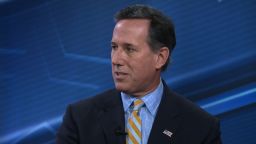Editor’s Note: Rick Santorum is a former Republican Senator from Pennsylvania and a contributor to CNN. He has worked closely with the Senate sponsors on the drafting of the Graham-Cassidy legislation. The views expressed here are solely his.
Story highlights
Rick Santorum: Senator Rand Paul's opposition to the Graham-Cassidy bill could potentially kill the bill
If that happens, Senator Paul would go from Obamacare's most principled foe to its most beloved savior, writes Santorum
On Monday, Senator Rand Paul said the Graham-Cassidy bill will not repeal Obamacare. This is the same faulty argument I heard from a few self-proclaimed principled conservatives in 1996 when we successfully challenged President Bill Clinton to keep his promise to end welfare as we know it. They said we promised in the election to end welfare – not, as Senator Paul now puts it, to “rearrange the furniture a bit.”
But Welfare Reform of 1996, like Graham-Cassidy, eliminated an uncapped entitlement, Aid to Families with Dependent Children, that was spiraling out of control and block-granted the money to the states with a cap on future spending. Also, like Graham-Cassidy, it gave states more – but not complete – flexibility in designing their programs.

That approach passed the Senate with 74 votes. There was one Republican holdout, Senator Lauch Faircloth of North Carolina, who, along with a small contingent of libertarian organizations, complained that this was not ending welfare but simply rearranging the furniture. They complained there weren’t enough tax and spending cuts and still too many federal strings attached.
According to a Heritage Foundation report, however, within three years of passage, welfare caseloads were reduced by over 50% nationwide. Poverty rates among some of the poorest demographics hit all-time lows, and employment among the chronically unemployed hit all-time highs. The program has worked so well the block grant for welfare has not been increased for 20 years, saving hundreds of billions of dollars.
In 1996, welfare, as we knew it, ended. In today’s language, it was repealed and replaced.
Was every element of the old welfare system changed? No.
Was all welfare spending repealed? No. In fact, according to the Urban Institute, unlike Graham-Cassidy, in the first few years after welfare reform was passed, states received more federal funds than they did prior to 1996.
Ending welfare as we know it was about ending a broken system and replacing it with a conservative approach that would save money and help low-income Americans enter the workforce. It was not about what the definition of “end” was.
Some offered amendments to completely end any federal income support for low-income Americans. Those amendments, like Rand Paul’s repeal only amendment, failed miserably.
Does Graham-Cassidy end or repeal Obamacare? Let’s look at what Obamacare is, and you can decide.
Obamacare is a federal law that requires every American to have and most businesses in America to provide health insurance. The penalty for noncompliance is a tax. The health insurance must be offered on a state or federally run exchange. Those insurance products must be approved by the federal government and must include coverage for abortions. In order to help lower-income people buy these government mandated plans, Obamacare provides tax credits and payments to insurance companies to offset these increasingly expensive plans.
Obamacare also expanded the federal health program for low-income Americans – Medicaid. If a state agreed to all of the requirements under Obamacare, it received money to pay for initially 100% of the cost, now 90% of the cost of the program. Thirty-one states and Washington DC have expanded their Medicaid programs.
Everything I have described is repealed under Graham-Cassidy. Everything.
No more health insurance mandates. No tax subsidies or payments to insurance companies. No Medicaid expansion. No abortion being paid for by public funds.
Now each state will have resources in a block grant, divided equally across all states, to design a health plan that fits the needs of its people.
Does it repeal all of the taxes? No, “just” $250 billion, including the anti-innovation medical device tax.
Does it repeal all the spending to help Americans purchase insurance? No, “just” $385 billion ($250 billion in tax cuts and $135 in direct spending cuts) over the next ten years.
Unlike welfare reform, Graham-Cassidy will likely pass or fail by one vote. The symbolic protest that the bill doesn’t eliminate every aspect of the old system was harmless in 1996. That protest for “perfection” by Senator Paul could be fatal for the last chance to repeal and replace Obamacare.
If that happens, Senator Paul would go from Obamacare’s most principled foe to its most beloved savior.





